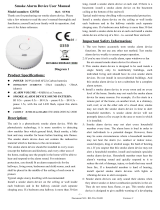FALSE ALARM CONTROL
Models GC240, I240C, PADC240, PG240, PAR230 and IAR230C feature False
Alarm Control that, when activated, quiets unwanted alarms for up to 15 minutes.
To use the False Alarm Control:
Press and release the test button during an unwanted alarm. The alarm
should stop within ten seconds. This means the smoke alarm is in False
Alarm Control. If the smoke alarm does not go into False Alarm Control
and continues to sound its loud alarm horn, or if it initially goes into False
Alarm Control then resounds the alarm, the smoke is too heavy and could
be a dangerous situation – take emergency action.
TESTING THE SMOKE ALARM
W ARNING
•
Test each smoke alarm to be sure it is installed correctly and operating
properly.
•
Test all smoke alarms in an interconnected system after installation.
•
The Push-to-Test button accurately tests all functions. DO NOT use an
open flame to test this smoke alarm. You may ignite and damage the
smoke alarm or your home.
•
Test smoke alarms weekly and upon returning from holiday or when no
one has been in the household for several days.
•
Stand at arm’s length from the smoke alarm when testing. The alarm
horn is loud to alert you to an emergency and can be harmful to hearing.
Test all smoke alarms weekly by doing the following:
1. Check Push-to-Test button. A constant green light indicates the smoke
alarm is receiving 230V AC, 50Hz power. A red flashing LED about once
a minute verifies operation. For models I240C, PAD240, PADC240,
IAR230C, and PAR230 the red flashing LED also verifies that a working
battery is present.
2. Firmly depress the Push-to-Test button for at least five (5) seconds. The
smoke alarm will sound a loud beep about four (4) times a second. The
alarm may sound for up to 10 seconds after releasing the Push-to-Test
button.
NOTE: If smoke alarms are interconnected, all smoke alarms should
sound an alarm within three seconds after any test button is
pushed and the tested smoke alarm sounds.
3. If smoke alarm does not sound, turn off power at main fuse box or cir-
cuit breaker and check wiring. Retest smoke alarm.
DANGER: If alarm horn sounds, and smoke alarm is not
being tested, the smoke alarm is sensing
smoke. THE SOUND OF THE ALARM HORN
REQUIRES YOUR IMMEDIATE ATTENTION AND
ACTION.
MAINTENANCE AND CLEANING
In addition to weekly testing, Models I240C, PAD240, and PADC240 also
require periodic battery replacement. Regularly clean smoke alarm to remove
dust, dirt, and debris.
WARNING: Alarm comes equipped with a dust cover,
which prevents dust and debris from
damaging the unit during construction or
remodeling. Remove dust cover before opera-
tion. Alarm will not operate properly while
covered.
DANGER: ELECTRICAL SHOCK HAZARD. Turn off main
power at fuse box or consumer unit by remov-
ing fuse or switching appropriate circuit
breaker to OFF position before replacing bat-
tery or cleaning smoke alarm.
BATTERY REPLACEMENT
(For Models I240C, PADC240, and PAD240 only):
CAUTION: Danger of explosion if battery is incorrectly
replaced.
Always turn off power to smoke alarm before replacing battery. Replace
battery at least once a year or immediately when the low battery signal
sounds once a minute, even though the smoke alarm is receiving AC power.
Use only the following batteries as replacements in this smoke alarm:
Eveready 216, 522, 1222; Duracell MN 1604; or Ultralife U9VL-J
Replace only with the same or equivalent battery type recommended
by the manufacturer. Discard used batteries safely according to
manufacturer's instructions.
WHENEVER THE BATTERY IS REPLACED,
TEST THE ALARM FOR CORRECT OPERATION
PUSHING THE TEST BUTTON.
WARNING: DO NOT USE ANY OTHER TYPE OF
BATTERY, EXCEPT AS SPECIFIED IN THIS
MANUAL. DO NOT USE RECHARGEABLE
BATTERIES.
(For Models IAR230C and PAR230 only):
NOTE: Rechargeable lithium batteries are permanently mounted and
sealed in the tamper-proof housing. These cells are designed to
last the useful life of the smoke alarm.
5
!
!
!
!
!
!











